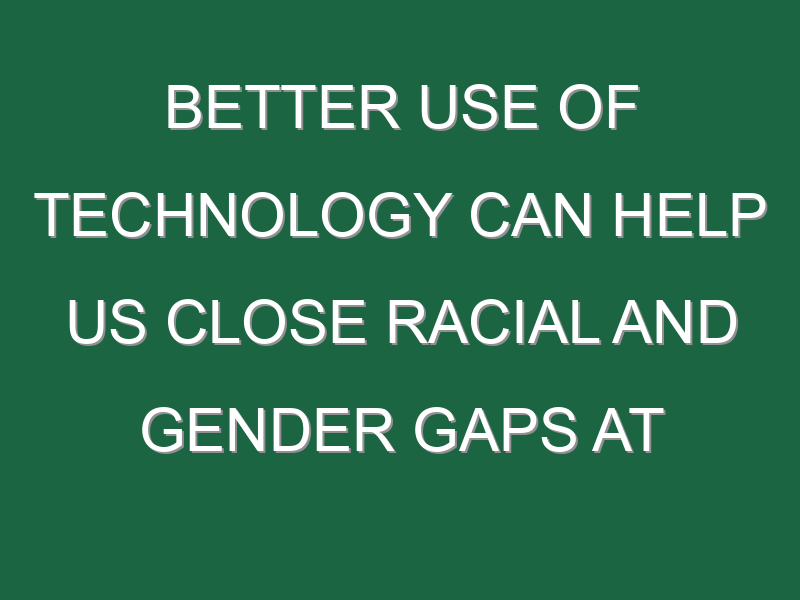Today’s businesses measure nearly everything with software. Hard “key performance indicators” or KPIs, such as number of calls, meetings, leads, and closes per month, supply the lifeblood to sales teams. Meanwhile, our marketing teams track every email open and build attribution models from first click to last. Finance and HR departments operate in a similar manner.
Individually, we use technology to optimize our sleep, our steps, and the sips of water we take every day. So why aren’t we using software to measure progress toward intersectional gender equity?
When we achieve intersectional gender equity, it means we will have closed all the gaps across gender, race, ethnicity that prevent people from fully participating in the economy. These gaps include the pay gap as well as gaps in promotion, performance evaluation, and access to opportunity. It’s about leveling the playing field so everyone—regardless of their gender or skin color—has the chance to realize their ambitions.
Software to close intersectional gender equity gaps exists. It’s powerful, it’s effective, and it’s the solution our well-intended diversity, equity, and inclusion (DEI) efforts have been waiting for.
We need new solutions to move the needle
By July 2020, Fortune 100 companies had pledged over $2 billion in new spending to racial justice causes. And prior to 2020, corporations were spending $8 billion annually on implicit bias training, even though a growing body of evidence shows that such training is generally ineffective and reinforces harmful stereotypes. Many corporations are now pledging to change representation percentages within their ranks and even tying managers’ pay to diversity measures. All of these solutions lack one thing: intersectionality. We cannot treat gender equity and racial equity as two distinct pillars of DEI. Here’s why.
Anyone who represents two or more diverse classes becomes a blind spot. Pipeline found through its implementations that men receive promotions at a 21% greater rate than women in aggregate. But when we applied the intersectional lens (i.e., when we disaggregated the data beyond gender), we found the promotion gap doubles for Black women. It’s not only these individuals who lose out. Entire organizations miss out on opportunities to build more inclusive and resilient businesses when they fail to account for intersectionality.
To some extent, their failure can be forgiven. Collecting, managing, and analyzing intersectional data on every employee, at every stage of the talent lifecycle, on every rung of the ladder, and across an entire organization is no small undertaking. However, the window of forgiveness, if it hasn’t closed yet, will close soon. Between COVID-19 accelerating digital adoption and the past year’s renewed calls for racial justice, companies that don’t take measures to close their intersectional gender gaps will be left behind.
The Fourth Industrial Revolution
Since the birth of the workforce diversity industry three decades ago, American corporations have poured billions of dollars into ineffective yet well-intended DEI solutions. For most companies, the pursuit of a more equitable workplace is like chasing a moving target. Will a new employee resource group, a better women’s leadership conference, a chief diversity officer, or a bigger donation to charity do the trick? It’s no wonder nine in 10 companies in a November study by consultancy McKinsey & Co. said they face challenges in executing their DEI strategy, even though DEI remains a top priority for them.
It’s time we start turning to what markets like best: efficiency. What is the most efficient (and effective) way to realize our DEI goals while accounting for intersectionality? Technology—artificial intelligence, specifically. With artificial intelligence, we can hardwire intersectional gender equity into the future of work. Welcome to the Fourth Industrial Revolution.
Pipeline’s customers see an average 65% increase in their intersectional gender equity progress in their first three months using the platform. That improvement, an overt win for DEI, also translates into real dollars for organizations. Our original research—conducted across 4,161 companies in 29 countries and collecting over a billion data points—found that for every 10% increase in intersectional gender equity, as measured by such metrics as representation at all levels of an organization and resources controlled, there is a 1% to 2% increase in revenue. What’s more, in an economic downturn, companies that embed equity in their crisis management strategies can enjoy up to a 50-percentage-point stock price improvement over a two-year period. It pays to prioritize intersectional inclusion.
If equity matters, measure it correctly
Commitments are great. Metrics are better. But without the right metrics, DEI efforts become empty promises. Companies want to “benchmark” their DEI numbers against other companies in their industries. That desire is well intended (they are attempting to control for variability among industries) and poorly thought out. DEI is generally not great at most companies across the board. If you benchmark against your industry peers, what you’re really saying is you are “less biased” than others in your industry. As business leaders running some of the most powerful organizations in the country, we need to hold ourselves to a higher standard.
How about we start with real numbers? Women are 51% of the population, 47% of the labor base, and 57% of all college graduates, according to Pew Research. So shouldn’t our metrics be based on at least 50/50 representation, if not more, to be truly equitable? When the number of female CEOs yo-yos year over year, and 7% is a record high, we have a problem. How did women go from 57% of college graduates, drop 10 points to 47% of the labor base, and then drop another 40 points to represent 7% of Fortune 500 CEOs? Those are the numbers we should be focusing on. Everything else is window dressing.
DEI solutions for the future of work
When 78% of CEOs rank gender equity among their top priorities yet only 22% of employees see it regularly shared and measured, according to Women in the Workplace, we have a problem. Commitments by CEOs and companies do not match their employees’ experience. Pipeline has confirmed this disconnect. On average, one-third of all performance reviews contain bias—meaning employees with similar performance receive different ratings as a result of individual evaluators’ bias.
The COVID-19 pandemic only reinforces the disconnect. Nearly 70% of business leaders agree that the pandemic will accelerate progress toward intersectional gender equity in the workplace, according to an Edelman Intelligence study conducted on behalf of Catalyst. But at the same time, only 39% of women and 45% of men believe that their workplaces are fully committed to the journey.
Let’s use the events of the past year as our invitation to transform empty promises into tangible progress using leading measures. For instance, companies make three key talent decisions each year: performance, potential, and pay. The average Fortune 500 company has 60,000 employees. That’s 180,000 opportunities for each company to move toward intersectional gender equity each and every year. For JPMorgan Chase and Starbucks—two companies that are tying manager pay to diversity targets—the number of opportunities to move toward intersectional gender equity each year are in the millions, 1.8 million to be exact. Across the entire Fortune 500, it’s 90 million opportunities.
With the tide rising toward stakeholder capitalism, it’s time to leverage tools of the Fourth Industrial Revolution to make intersectional gender equity a reality, to make stakeholder capitalism a reality, and to catapult our economic recovery. Better financial outcomes are on the other side waiting for us.
Katica Roy is a gender economist and the CEO and founder of Pipeline, a SaaS company that leverages artificial intelligence to identify and drive economic gains through gender equity.
More opinion from Fortune:
- Why the U.S. needs a national climate investment fund
- Why “soft robots” have NASA, doctors, and tech whizzes so excited
- 20 things that went strangely, wonderfully right in 2020
- Marketers can’t predict what you’ll buy—even if they use A.I.
- Why the PPP still falls short for small businesses




